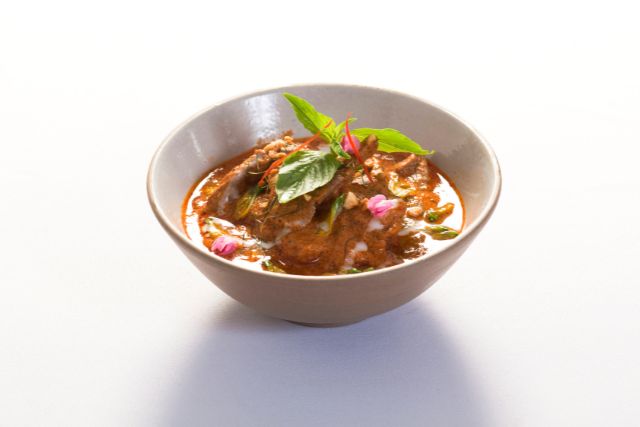
Thai Red Curry Duck with Lychee and Pineapple
Thai red curry duck is a luxurious dish that harmoniously blends the rich, savory flavor of duck with the sweet and tropical notes of lychee and pineapple. This dish is a vibrant example of the complexity and balance in Thai cuisine, where sweet, spicy, sour, and salty elements come together in perfect harmony. The creamy coconut-based red curry sauce infused with aromatic spices envelops the tender duck, while the lychee and pineapple add a burst of juicy sweetness. If you’re looking to create a dish that is both comforting and elegant, this Thai red curry duck is sure to impress. Let’s take a closer look at how you can make it at home.
Ingredients:
For the Duck:
- 2 duck breasts, skin on
- 1 tablespoon vegetable oil
- Salt and pepper, to taste
For the Red Curry:
- 2 tablespoons red curry paste (store-bought or homemade)
- 1 can (400ml) coconut milk
- 1/2 cup chicken broth or water
- 1 tablespoon fish sauce
- 1 tablespoon palm sugar (or brown sugar)
- 1/2 cup fresh pineapple, cut into bite-sized pieces
- 1/2 cup canned lychee (drained) or fresh lychee, peeled and pitted
- 1-2 kaffir lime leaves (optional)
- 1 red chili, sliced (optional, for extra heat)
- A handful of Thai basil leaves
- 1 tablespoon lime juice
Instructions:
Step 1: Prepare the Duck
Start by scoring the skin of the duck breasts with a sharp knife, making crosshatch patterns. This will help render the fat and give you crispy skin. Season both sides of the duck breasts with salt and pepper.
Heat a large skillet over medium-high heat and add the vegetable oil. Place the duck breasts skin-side down and cook for about 5-7 minutes, or until the skin is crispy and golden brown. Flip the duck breasts over and cook for another 3-4 minutes, depending on how rare you like your duck (internal temperature should reach 135°F/57°C for medium-rare).
Remove the duck from the skillet and let it rest for 10 minutes before slicing. This resting period will allow the juices to redistribute, making the meat tender and juicy.
Step 2: Make the Red Curry Sauce
In the same skillet, remove excess duck fat, leaving about 1 tablespoon in the pan for flavor. Add the red curry paste and sauté it for 1-2 minutes over medium heat until fragrant, releasing the rich aroma of the spices.
Slowly pour in the coconut milk, stirring constantly to combine with the curry paste. Add the chicken broth or water to thin the sauce slightly. Bring the mixture to a simmer.
Next, stir in the fish sauce and palm sugar, balancing the saltiness and sweetness of the curry. Add the kaffir lime leaves (if using) and continue simmering for 5-10 minutes, allowing the flavors to meld.
Step 3: Add the Lychee and Pineapple
Once the curry sauce has thickened slightly, stir in the pineapple chunks and lychee. These sweet fruits will bring a tropical burst of flavor, complementing the richness of the duck and the spiciness of the curry. Simmer for another 5 minutes, just until the fruit is warmed through but still retains its texture.
Step 4: Assemble and Garnish
Slice the rested duck breasts thinly and add them to the curry, allowing the meat to warm up gently in the sauce for a minute or two. Stir in the lime juice to brighten the flavors, then remove the pan from the heat.
Garnish the curry with fresh Thai basil leaves and sliced red chili if you prefer extra heat. The vibrant colors and fragrant herbs will enhance the presentation and flavor of the dish.
Step 5: Serve
Serve the Thai red curry duck with steamed jasmine rice or sticky rice to soak up the rich, flavorful sauce. For a complete meal, you can also add a side of stir-fried vegetables, like baby bok choy or snap peas, to balance the richness of the curry.
Tips for Success:
- Balance the Flavors: Thai cuisine is all about balance. Taste the curry sauce before adding the duck and adjust the flavors as needed. If it’s too salty, add a little more palm sugar. If it’s too sweet, add a bit more fish sauce or lime juice.
- Crispy Duck Skin: For extra crispy duck skin, ensure that you start with a hot skillet and cook the duck skin-side down until the fat renders and turns golden brown.
- Control the Heat: Red curry paste can vary in spiciness depending on the brand. Start with 1 tablespoon if you’re sensitive to heat, and gradually add more as you go. You can also add fresh chili for additional heat if desired.
- Use Fresh Lychee: If you can find fresh lychee, it adds a beautiful texture and flavor to the dish. However, canned lychee works just as well, providing a convenient option without sacrificing flavor.
Variations:
- Pineapple and Mango Curry: If you want to switch up the fruit combination, try adding fresh mango slices instead of lychee for a different sweet element.
- Vegetarian Red Curry: For a meatless version, substitute the duck with tofu or mixed vegetables such as bell peppers, eggplant, and green beans.
- Green Curry Option: If you prefer a milder flavor with more herbal notes, you can swap the red curry paste for green curry paste, which uses ingredients like green chilies, Thai basil, and lemongrass.
This flavorful curry pairs wonderfully with fragrant jasmine rice, which absorbs the rich sauce. You can also serve it with crispy spring rolls or a light Thai cucumber salad for a refreshing contrast. If you want to make it a full feast, consider adding a bowl of Tom Yum soup as a starter.
Thai red curry duck with lychee and pineapple is a delightful fusion of flavors and textures, bringing together the richness of the duck, the creaminess of coconut milk, and the sweet tang of tropical fruits. This dish is a perfect example of the balance of flavors that makes Thai cuisine so special. Whether you’re preparing it for a special occasion or a weekend dinner, this dish promises to be a hit at your table. Enjoy the exotic flavors and vibrant colors of Thailand in the comfort of your own kitchen!
Disclaimer: The information provided in this article is for general information purposes only. All information in this article is sourced from other websites, and we do not represent any rights regarding the contents and information on the site. All rights belong to their original owner.
